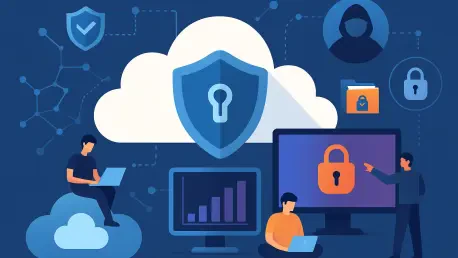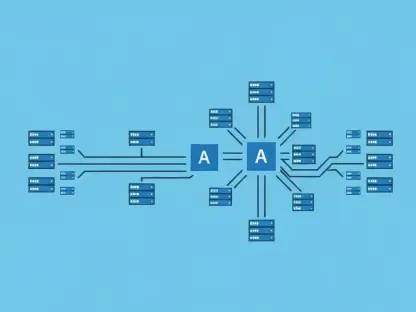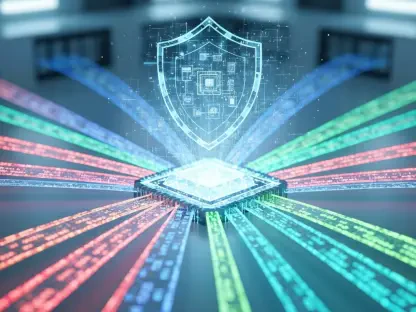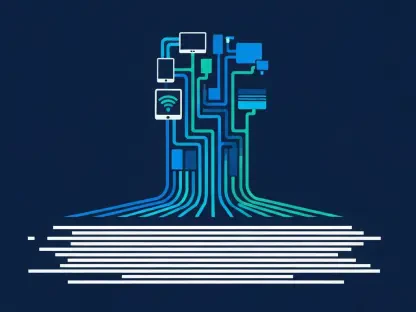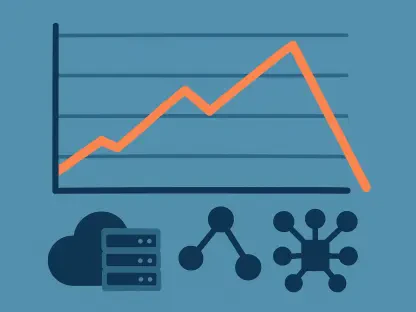In a world where digital transformation accelerates at an unprecedented pace, the intersection of cloud computing and cybersecurity has become a battleground for innovation and resilience in 2025, shaping how organizations protect their digital assets. Insights from two pivotal industry events—CloudX in Santa Clara, California, and the Cyber Security & Cloud Expo Global in London—reveal a profound shift in how organizations are tackling the challenges of securing expansive digital infrastructures. These gatherings united tech leaders, engineers, and visionaries to address the evolving threats and opportunities that define the current landscape. Their discussions underscored a critical realization: cybersecurity is no longer an optional layer but an integral part of cloud strategy that demands attention at every level.
The themes emerging from these events point to a holistic approach where technology, human behavior, and strategic foresight converge to build robust defenses. From proactive vulnerability management to the integration of cutting-edge tools, the focus is on staying ahead of sophisticated cyber risks. These trends are not just shaping current practices but are setting the stage for how businesses will operate in the coming years. For anyone invested in the digital realm, understanding these shifts is essential to navigating the complexities of a connected world.
Security as the Foundation of Cloud Strategy
Embedding Vulnerability Management
A central takeaway from the Santa Clara event is the undeniable importance of embedding security directly into the core of cloud infrastructure. Experts at the conference stressed that managing vulnerabilities must be a proactive endeavor rather than a reactive fix after breaches occur. This approach involves designing cloud systems with security as a fundamental element, ensuring that potential weaknesses are identified and mitigated before they can be exploited. The emphasis on preemptive measures reflects a broader industry acknowledgment that trust and stability in digital environments hinge on robust, forward-thinking risk management. As cyber threats grow in complexity, organizations are recognizing that neglecting this foundational aspect can lead to catastrophic consequences, both financially and reputationally.
Beyond just architecture, this trend also calls for continuous monitoring and scalable solutions to adapt to emerging risks. Sessions highlighted the necessity of tools and processes that can evolve with the threat landscape, ensuring that vulnerabilities are not just patched temporarily but addressed systematically. This shift in mindset moves away from viewing security as a burden and toward seeing it as a competitive advantage. Companies that prioritize this integration are better positioned to maintain operational integrity while fostering confidence among stakeholders. The message is clear: in 2025, vulnerability management is not an option but a critical imperative for any cloud-driven enterprise aiming to thrive.
Building a Security-First Culture
Another key aspect of making security foundational is cultivating a culture that prioritizes it across all levels of an organization. Discussions at the event pointed to the need for education and training programs that equip employees with the knowledge to recognize and respond to potential threats. This cultural shift ensures that security considerations are not confined to IT departments but are ingrained in every decision and process. By fostering awareness, businesses can reduce the likelihood of human error, which often serves as an entry point for cyberattacks. The focus here is on creating a shared responsibility model where everyone plays a role in safeguarding digital assets.
Moreover, leadership buy-in is essential to drive this cultural transformation, as top executives must champion security initiatives and allocate resources accordingly. Insights from industry panels suggested that when leaders visibly prioritize cybersecurity, it sets a tone that permeates throughout the organization. This trend also involves aligning security goals with business objectives, ensuring that protective measures enhance rather than hinder growth. As organizations navigate the digital economy in 2025, embedding a security-first culture becomes a cornerstone of sustainable success, reinforcing the idea that prevention is far more effective than cure.
Convergence of Technology and Collaboration
DevSecOps and AI in Cloud Transformation
One of the most compelling trends highlighted at both industry events is the seamless integration of DevSecOps, artificial intelligence, and cloud transformation initiatives. This convergence is reshaping how organizations develop, deploy, and secure their digital ecosystems by embedding security practices directly into development and operations workflows. Sessions in Santa Clara focused on how automating security within DevOps pipelines, paired with AI-driven threat detection, creates agile and resilient systems. Meanwhile, hybrid cloud architectures are enabling flexibility, allowing businesses to scale securely across diverse environments. This interconnected approach breaks down traditional silos, fostering collaboration among teams to drive both innovation and protection.
Further exploration of this trend reveals the transformative potential of AI in enhancing real-time threat monitoring and response capabilities. By leveraging machine learning algorithms, organizations can predict and neutralize risks before they escalate, a capability that is becoming indispensable in 2025. The London event emphasized the importance of aligning development, operations, and security teams to ensure that rapid deployment does not compromise safety. This trend signals a move toward ecosystems where technology and teamwork are equally prioritized, ensuring that cloud transformation is both efficient and secure. As digital landscapes expand, embracing this convergence is vital for staying competitive and resilient.
Fostering Cross-Functional Synergy
Another dimension of this technological convergence is the push for cross-functional synergy within organizations adopting cloud and security solutions. Panels at the events underscored that successful implementation of DevSecOps and AI tools requires breaking down barriers between departments, encouraging open communication, and shared goals. This collaborative ethos ensures that security considerations are not an afterthought but are integrated from the ideation phase through to deployment. By aligning diverse teams, companies can address potential vulnerabilities early, reducing friction and enhancing overall system integrity in dynamic cloud environments.
Additionally, this trend highlights the role of standardized frameworks and tools that facilitate interoperability across different functions and technologies. Experts pointed to the adoption of unified platforms that allow for seamless data sharing and coordinated responses to threats. Such systems empower teams to work cohesively, leveraging AI insights to inform decision-making while maintaining agility in cloud operations. As businesses face increasingly complex challenges in 2025, fostering this level of synergy is not just beneficial but necessary to create robust, adaptable digital infrastructures that can withstand evolving cyber risks.
People-Centric Cybersecurity Approaches
Zero Trust and Human Behavior in Defense
A significant insight from the London event is the growing recognition that cybersecurity extends beyond technology to encompass human behavior and strategic leadership. Frameworks like Zero Trust, which operate on the principle of verifying every access request regardless of origin, are gaining traction as a means to build resilient networks. Experts emphasized that employees often represent both the first line of defense and a potential vulnerability, making behavioral training a critical component of security strategies. By viewing staff as allies in safeguarding systems, organizations can significantly reduce risks stemming from phishing attacks or inadvertent errors.
Complementing this focus on human factors is the evolving role of cybersecurity leadership, particularly for Chief Information Security Officers. Discussions highlighted that these roles now demand skills in communication and cultural influence alongside technical expertise. Leaders are tasked with fostering a security-conscious mindset throughout the organization, ensuring that policies resonate with employees at all levels. This trend reflects a broader shift toward people-centric approaches, acknowledging that even the most advanced tools are ineffective without human diligence. In 2025, balancing technological frameworks with behavioral insights is essential for comprehensive defense.
Empowering Leadership for Cultural Change
Delving deeper into the human element, the events shed light on how cybersecurity leadership is pivotal in driving cultural change within organizations. Panels noted that leaders must act as advocates for security, bridging the gap between technical teams and broader business units to align goals. This involves not only implementing frameworks like Secure Access Service Edge but also ensuring that the rationale behind such measures is clearly communicated to all stakeholders. Effective leadership transforms security from a perceived obstacle into a shared value, encouraging proactive participation across departments.
Furthermore, this trend emphasizes the importance of tailored training programs that address specific risks faced by different roles within a company. By customizing education to reflect real-world scenarios, leaders can empower employees to make informed decisions under pressure. The London discussions revealed that organizations prioritizing such initiatives see measurable improvements in incident response times and overall resilience. As cyber threats become more targeted in 2025, strong leadership that champions a people-first approach will be a defining factor in building enduring digital defenses.
Artificial Intelligence: Friend and Foe
Balancing AI’s Benefits and Risks
Artificial intelligence emerged as a dominant theme at both industry events, celebrated for its potential to revolutionize cybersecurity while simultaneously posing significant risks. On one hand, AI tools excel at detecting vulnerabilities, automating patch management, and predicting attack patterns with unprecedented accuracy. These capabilities enable organizations to stay ahead of threats, minimizing damage through rapid response mechanisms. However, the same technology can be weaponized by adversaries to orchestrate sophisticated cyberattacks, from deepfake scams to automated malware deployment. This dual nature necessitates a delicate balance, where businesses must leverage AI’s strengths while actively guarding against its misuse.
The urgency of adapting to AI’s evolving role was a recurring point in expert sessions, with a clear consensus that ignoring this technology is no longer an option. Defensive algorithms must continuously evolve to counter AI-powered threats, requiring investment in research and development. Additionally, regulatory frameworks are beginning to emerge to address ethical concerns surrounding AI deployment in security contexts. As the digital battlefield transforms in 2025, organizations face the challenge of harnessing AI’s potential without becoming vulnerable to its darker applications, making strategic planning more critical than ever.
Developing Adaptive AI Strategies
Beyond recognizing AI’s dual role, there is a pressing need to develop adaptive strategies that keep pace with its rapid advancements. Insights from the events suggest that organizations must prioritize flexibility in their AI implementations, ensuring systems can be updated as new threats emerge. This involves not only deploying AI for threat detection but also using it to simulate potential attack scenarios, thereby identifying weaknesses before they are exploited. Such proactive use of technology can significantly enhance a company’s security posture, turning AI into a dynamic shield rather than a static tool.
Moreover, collaboration between industry players to share AI-driven threat intelligence is becoming increasingly vital. Panels highlighted how collective data pools can improve predictive models, offering broader protection against global cyber risks. This cooperative approach also helps smaller organizations access cutting-edge defenses that might otherwise be out of reach. In 2025, as AI continues to shape the cybersecurity landscape, developing strategies that emphasize adaptability and collaboration will determine which entities thrive amidst constant technological disruption.
Practical Solutions from Real-World Insights
Learning from Case Studies
Among the most impactful takeaways from the events were the real-world case studies shared by industry experts, offering tangible lessons for immediate application. Presentations detailed findings from extensive penetration testing, revealing common systemic weaknesses that many organizations overlook. These insights provided actionable frameworks for exposure risk management, helping businesses prioritize critical vulnerabilities. Additionally, strategies for cyber resilience were discussed, focusing on navigating both active threats and stringent regulatory demands. This trend toward practicality ensures that cybersecurity solutions are grounded in lived experiences rather than abstract theories.
The value of these case studies lies in their ability to translate complex challenges into clear, replicable playbooks. For instance, experts showcased how specific response protocols mitigated large-scale breaches, offering a blueprint for others to follow. This focus on tested solutions addresses the industry’s demand for approaches that can be implemented swiftly and effectively. In 2025, as cyber threats grow in frequency and sophistication, drawing from such real-world insights becomes a cornerstone of building defenses that are not just robust but also adaptable to unique organizational needs.
Applying Tested Frameworks for Resilience
Expanding on the practical focus, the events also emphasized the importance of applying tested frameworks to enhance cyber resilience across diverse sectors. Discussions revealed how structured approaches to risk assessment and incident response can be customized to fit specific industry challenges, ensuring relevance and impact. These frameworks often integrate lessons from past breaches, providing a roadmap for anticipating and countering similar threats. By adopting such proven methods, organizations can avoid reinventing the wheel, instead leveraging collective knowledge to strengthen their security posture.
Furthermore, the application of these frameworks often involves cross-referencing with regulatory standards to ensure compliance while maintaining operational efficiency. Experts at the conferences shared examples of how aligning security practices with legal requirements not only mitigates risks but also builds trust with clients and partners. This practical trend underscores a shift toward solutions that are both effective and sustainable, addressing immediate needs while preparing for future uncertainties. In 2025, prioritizing such tested strategies will be key to navigating the complex interplay of technology, policy, and threat evolution.
The Future of Digital Defense
Integration and Adaptability
Looking back at the profound insights shared at the industry events in Santa Clara and London, it becomes evident that the trajectory of cloud and cybersecurity has shifted toward integration and adaptability. Security is no longer treated as a peripheral concern but is woven into every facet of digital strategy, ensuring that vulnerabilities are addressed at their root. The convergence of DevSecOps with artificial intelligence has redefined collaboration, creating ecosystems where agility and protection go hand in hand. Meanwhile, the emphasis on human behavior alongside frameworks like Zero Trust has highlighted the indispensable role of people in fortifying defenses.
Charting the Path Ahead
Reflecting on these discussions, the dual nature of AI stands out as both a groundbreaking tool and a formidable challenge, urging organizations to balance innovation with caution. Real-world case studies have provided a pragmatic foundation, equipping businesses with actionable steps to counter evolving threats. Moving forward, the focus should be on fostering continuous evolution—investing in adaptive technologies, prioritizing employee training, and building collaborative networks for shared intelligence. These steps will ensure that digital defenses remain robust in the face of future uncertainties, setting a standard for resilience and foresight in an ever-changing landscape.
